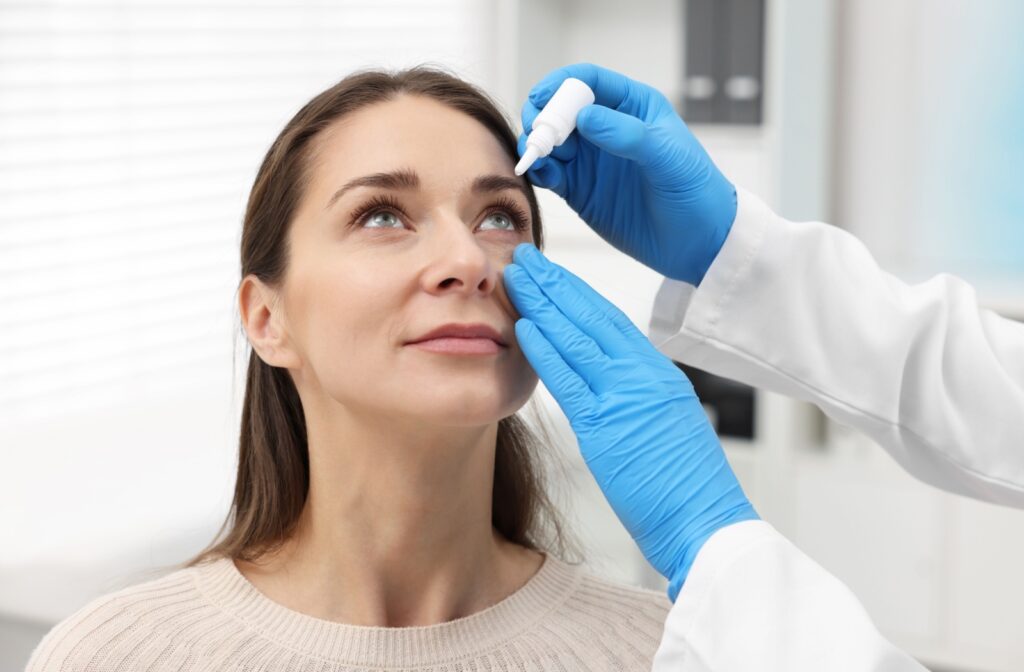Dry, itchy, or burning eyes might seem like just an uncomfortable nuisance. For many, it’s easy to dismiss them as just another part of sitting in front of screens or living in a dry climate. However, untreated chronic dry eye can damage your eyes, leading to conditions such as corneal ulcers and scarring that can affect your vision. That said, it’s essential to recognize that dry eye syndrome does not directly cause blindness.
Understanding Dry Eye Syndrome
Dry eye syndrome occurs when your eyes don’t produce enough tears or when the tears evaporate too quickly. Tears, as simple as they might seem, are essential to keeping your eyes nourished and protected. Without them, your eyes can become irritated and vulnerable to damage.
Common Symptoms
Here are the classic signs of dry eye syndrome to keep on your radar:
- A gritty or sandy feeling in your eyes
- Redness or inflammation
- Blurred vision, especially after reading or screen use
- Sensitivity to light
- Eye fatigue or discomfort
Causes
Dry eye has many causes, from environmental factors to underlying health conditions. Some of the most common culprits include:
- Aging (particularly among those 50+)
- Extended screen time, leading to reduced blinking
- Weather conditions, such as dry air or wind
- Medical conditions like diabetes or rheumatoid arthritis
- Medications, including antihistamines and antidepressants
- Contact lens wear
Understanding what’s causing your dry eyes is the first step toward effective treatment. But as we’ll soon see, dry eye can sometimes have more serious consequences.
Link Between Dry Eye & Vision
You may wonder how a seemingly simple issue, such as dry eyes, could impact your vision. The connection is more direct than you think. Left untreated, severe dry eye syndrome can damage the surface of the eye, causing abrasions, ulcers, or even scarring.
Over time, this damage can make your eyes more susceptible to infections, potentially further compromising your vision. While it’s rare for dry eye itself to cause blindness, complications from untreated cases can lead to significant and lasting vision problems.
Understanding the Risk of Blindness
The risk of blindness associated with dry eye syndrome is particularly pronounced in extreme cases. For instance, individuals with severe underlying conditions (such as Sjögren’s syndrome) may experience chronic dryness that leads to corneal ulcers or scarring. This damage can interfere with how light enters the eye, potentially causing permanent vision impairment.
But here’s the good news: with proper care and intervention, the risk of blindness from dry eye drops significantly. Recognizing symptoms early and taking preventative measures are key to protecting your long-term eye health.
Preventative Measures & Treatments
The sooner you address your dry eye symptoms, the easier it is to manage them and avoid more serious complications. Below, we’ll explore solutions ranging from everyday lifestyle changes to advanced medical therapies.
Lifestyle Changes
A few simple adjustments to your daily routine can go a long way in reducing symptoms:
- Stay hydrated: Drinking plenty of water supports healthy tear production.
- Use a humidifier: Adding moisture to the air can prevent your tears from evaporating too quickly.
- Take screen breaks: Follow the 20-20-20 rule—look at something 20 feet away for 20 seconds every 20 minutes.
- Protect your eyes: Wear sunglasses that block UV light and shield against wind or debris.
Over-the-Counter (OTC) Solutions
Many mild cases of dry eye can be managed with OTC remedies that are widely accessible:
- Artificial tears: These eye drops can provide temporary relief from dryness. To reduce irritation, look for preservative-free options.
- Lid wipes/cleansers: Keeping your eyelids clean can help reduce inflammation caused by blepharitis, a common contributor to dry eye.
- Omega-3 supplements: Studies are ongoing, but omega-3 fatty acids may help improve the quality of your tear film.
Prescription Treatments
If OTC approaches aren’t enough, your eye doctor may recommend stronger options:
- Prescription eye drops: Anti-inflammatory drops such as cyclosporine (Restasis) or lifitegrast (Xiidra) can help manage chronic dryness.
- Medications for underlying conditions: If an autoimmune disease or other health problem is contributing to your dry eyes, treating that condition can improve your symptoms.
Advanced Therapies
For those with severe or persistent dry eye, advanced treatments are available:
- Punctal Plugs: Tiny devices inserted into tear ducts to prevent tear drainage and keep your eyes hydrated longer.
- Meibomian Gland Expression: A procedure to clean out clogged glands that produce the oily layer of your tear film.
- Intense Pulsed Light (IPL) Therapy: Originally used for skin conditions, IPL has shown promising results for improving dry eye symptoms.
- Autoimmune Therapies: Biologic therapies, such as monoclonal antibodies, may provide relief for patients with severe systemic conditions.

When to Talk to Your Eye Doctor
Dry eye isn’t always just an annoyance. If any of the following apply to you, it’s time to consult an eye care professional:
- Your symptoms persist despite trying OTC solutions.
- You experience blurry vision that affects your ability to work or drive.
- You have chronic redness or discomfort.
- You notice heightened sensitivity to light.
Eye doctors are equipped with diagnostic tools, including tear film imaging and osmolarity testing, to understand your needs. By working closely with your doctor, you can develop a personalized plan to manage your dry eye symptoms effectively.
Protect Your Vision Before It’s Too Late
Dry eye syndrome may not seem like a significant issue at first glance, but it can escalate into more serious problems if left untreated. Vision Care Centre encourages our patients to take care of their vision by improving their hydration habits, adjusting their workspace setup, and seeking medical help when needed. Contact us today to learn how we can help alleviate your dry eye symptoms.



